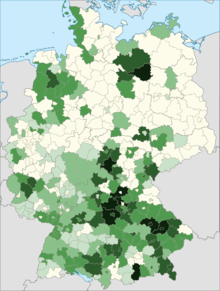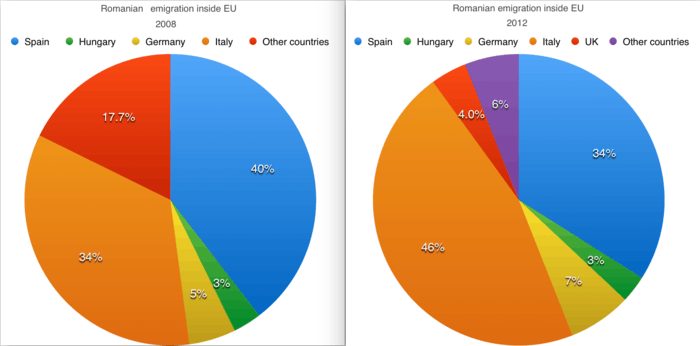Romanians in Germany
 Distribution of Romanian citizens in Germany (2014) | |
| Total population | |
|---|---|
|
1,130,789 to 2,000,000 (with Romanian ancestry)[1][2] 452,718 (Romanian citizens)[3] | |
| Regions with significant populations | |
| Berlin · Munich · Frankfurt · Hamburg · Rhein-Ruhr · Nuremberg · Stuttgart | |
| Languages | |
| Religion | |
|
Predominantly † Orthodox Christianity | |
| Related ethnic groups | |
|
All Romance peoples as well as other Central and Southeastern European peoples; See also: Vlachs, Moldovans, Aromanians, Megleno-Romanians, Istro-Romanians |
Romanians in Germany, are one of the sizable communities of the Romanian diaspora in Western Europe. According to German statistical data from 2016, the number of Romanian nationals in Germany on 31 December 2015 was 452,718 (up from 94,326 in 2008).[4]
History
Emigration to Germany from Romania was common throughout the 20th century, and continued steadily way into the early 21st century. Large numbers of ethnic Germans of Romania (most notably Transylvanian Saxons and Banat Swabians) left the country prior, during, and after the events that ultimately led to World War II.
In the times of the communist regime in Romania, albeit the borders were officially closed by authorities, significant numbers of Romanian-Germans were allowed to emigrate to West Germany, particularly in the later years of the Ceaușescu era. This formed part of a series of ethnic migrations (including Jews to Israel and Hungarians to Hungary), which were tolerated under the then socialist rulership. During the 1980s, more than half of the people who left Romania went to Germany.[5]
After the Romanian Revolution which took place in December of 1989, there has been a mass migration of Transylvania Saxons to Germany, in what was referred by British daily newspaper Guardian to as 'the most astonishing, and little reported, ethnic migration in modern Europe'.[6]
Emigration of ethnic Romanians to Germany become quite common in the 21st century, particularly after the entry of Romania in the European Union in 2007. The Romanian diaspora in Germany has a strong presence. If descent is actually taken into account as the main criterion of immigration, then the total number of individuals living in Germany who stem from Romania (both Romanian-German and Romanian) may amount to as much as 2,000,000 residents, therefore putting the Romanian diaspora living in this country the largest of all Romanian ones living within the European Union.
Romanian-German minority
Footnotes
- ↑ "Publikation - Bevölkerung - Bevölkerung mit Migrationshintergrund - Ergebnisse des Mikrozensus - Fachserie 1 Reihe 2.2 - 2015 - Statistisches Bundesamt (Destatis)".
- ↑ This figure might equally include Romanian-Germans who emigrated before and after 1989, firstly to West Germany then to unified Germany, most notably the sub-groups of Transylvanian Saxons, Banat Swabians, Bukovina Germans, or Bessarabia Germans.
- ↑ https://www.destatis.de/DE/Publikationen/Thematisch/Bevoelkerung/MigrationIntegration/AuslaendBevoelkerung.html?nn=68748
- ↑ "Ausländische Bevölkerung. Ergebnisse des Ausländerzentralregisters" (in German). Statistisches Bundesamt. 2016. p. 37. Retrieved 2016-10-29.
- ↑ Porumbescu, Alexandra (2015). "Historical Landmarks of the Romanian's Migration to Germany" (PDF). Journal of Humanities, Culture and Social Sciences. 1 (1): 27–40. ISSN 2393-5960.
- ↑ Jenkins, Simon (2009-10-01). "A forgotten Saxon world shows how ancient and modern can co-exist". The Guardian. Retrieved 2018-09-25.
Gallery
 Romanian embassy in Berlin
Romanian embassy in Berlin Romanian general consulate in Bonn, North Rhine-Westphalia
Romanian general consulate in Bonn, North Rhine-Westphalia Two separate charts indicating the Romanian diaspora living inside the European Union between 2008 and 2012. Romanian immigration to Germany is depicted in yellow.
Two separate charts indicating the Romanian diaspora living inside the European Union between 2008 and 2012. Romanian immigration to Germany is depicted in yellow.
